Modelling Debris Flow Runout: A Case Study on the Mesilau Watershed, Kundasang, Sabah
Abstract
:1. Introduction
2. Materials and Methods
2.1. Study Area
2.2. Datasets
2.3. Base Model Extraction
2.4. Rainfall Runoff Processes
2.5. Debris Flow Modelling
3. Results
3.1. Best-Fit Debris Flow Runout
3.2. Flow Depth and Depositional Thickness of Best-Fit Runout
3.3. Estimated Velocity and Lead Time
4. Discussion
5. Conclusions
- (1)
- The debris flow happened on 15 June 2015, i.e., ten days after the 2015 Ranau earthquake (Mw 6.0) with a seven-day cumulative rainfall of 66.3 mm. The maximum rainfall intensity was 14.2 mm/h; it breached the landslide dam and initiated the debris flow. The early identification showed that the least amount of rainfall was sufficient to trigger the debris flow after the earthquake in the Mesilau watershed.
- (2)
- According to the best-fit simulation, the debris flow velocity was estimated to be 12.5 m/s and the lead time to arrive at the nearest Mesilau village was 4.5 min, representing the required evacuation time by the community to minimise the debris flow impacts and prevent human losses.
- (3)
- Additionally, the baseflow during the past event was 550 m3/s, yielding a discharge of 563.8 m3/s. According to the reference value of the Kenyir lake [62], the baseflow for the Mesilau watershed should not exceed the baseflow of water bodies, i.e., 950 m3/s.
- (4)
- The approximate runout distance flowing from the landslide dam to the Liwagu Dam of the Ranau town was 18.6 km, due to a large amount of sediment supply (accumulated debris) generated during the 2015 Ranau earthquake.
- (5)
- As the debris began flowing, the flow depth gradually decreased from 15.0 m at the initiation area to 5.0 m at the deposition area. In Zone B (the Mesilau village), the flow depth ranged from 1.0 to 10.0 m with no overflowing debris identified. In Zone E (the Liwagu Dam), the depositional thickness was less than 5.0 m; the closed dam blocked the accumulated debris along the channel.
Author Contributions
Funding
Acknowledgments
Conflicts of Interest
References and Note
- Santi, P.M.; Hewitt, K.; VanDine, D.F.; Cruz, E.B. Debris-flow impact, vulnerability, and response. Nat. Hazards 2011, 56, 371–402. [Google Scholar] [CrossRef]
- Shugar, D.H.; Jacquemart, M.; Shean, D.; Bhushan, S.; Upadhyay, K.; Sattar, A.; Schwanghart, W.; McBride, S.; de Vries, M.V.W.; Mergili, M.; et al. A massive rock and ice avalanche caused the 2021 disaster at Chamoli, Indian Himalaya. Science 2021, 373, 300–306. [Google Scholar] [CrossRef] [PubMed]
- Petley, D. The Atami Mudslides in Japan. Available online: https://blogs.agu.org/landslideblog/2021/07/05/atami-mudslides/ (accessed on 2 August 2021).
- Radhi, R. 47 Lokasi Tanah Runtuh Di Gunung Jerai Dikenal Pasti. Available online: https://www.getaran.my/artikel/semasa/10261/47-lokasi-tanah-runtuh-di-gunung-jerai-dikenal-pasti (accessed on 10 September 2021).
- Jabatan Mineral dan Geosains. The Early Assessment of Debris Flow in Gunung Jerai, Kedah. Kedah. Virtual Interview by Muhammad Iylia Rosli. 13 September 2021.
- Mukhlisin, M.; Matlan, S.J.; Ahlan, M.J.; Taha, M.R. Analysis of Rainfall Effect to Slope Stability in Ulu Klang, Malaysia. J. Teknol. 2015, 72, 15–21. [Google Scholar] [CrossRef] [Green Version]
- Rosli, M.I.; Kamal, N.A.M.; Razak, K.A. Assessing Earthquake-induced Debris Flow Risk in the first UNESCO World Heritage in Malaysia. Remote Sens. Appl. Soc. Environ. 2021, 23, 100550. [Google Scholar] [CrossRef]
- Tongkul, F. The 2015 Ranau Earthquake: Cause and Impact. Sabah Soc. J. 2016, 32, 1–28. [Google Scholar]
- Chow, W.; Jadid, M.S.M.; Yaacob, S. Geological and geomorphological investigations of debris flow at Genting Sempah, Selangor. In Proceedings of the GSM, Forum on Geohazards: Landslide & Subsidence, Kuala Lumpur, Malaysia, 22 October 1996; pp. 5.1–5.15. [Google Scholar]
- Ghazali, M.A.; Rafek, A.G.; Desa, K.M.; Jamaluddin, S. Effectiveness of Geoelectrical Resistivity Surveys for the Detection of a Debris Flow Causative Water Conducting Zone at KM 9, Gap-Fraser’s Hill Road (FT 148), Fraser’s Hill, Pahang, Malaysia. J. Geol. Res. 2013, 2013, 1–11. [Google Scholar] [CrossRef] [Green Version]
- Hashim, K.; Among, H.L. Geological investigation on Ruan Changkul landslide. Bull. Geol. Soc. Malays. 2003, 46, 125–132. [Google Scholar] [CrossRef]
- Huat, L.T.; Ali, F.; Osman, A.R.; Rahman, N.A. Web based real time monitoring system along North-South Expressway, Malaysia. Electron. J. Geotech. Eng. 2012, 17, 623–632. [Google Scholar]
- Jaafar, K. Heavy rainfall intensity triggering the landslide at Sungai Ruil Cameron Highland Malaysia-A Case study. In Proceedings of the EGU General Assembly Conference Abstracts, Vienna, Austria, 22–27 April 2012; p. 13728. [Google Scholar]
- Jamaludin, S.; Abdullah, C.H.; Kasim, N. Rainfall Intensity and Duration for Debris Flow Triggering in Peninsular Malaysia. In Landslide Science for a Safer Geoenvironment; Springer Science and Business Media LLC: Berlin, Germany, 2014; pp. 167–172. [Google Scholar]
- Jamaludin, S.; Hussein, A.N. Landslide hazard and risk assessment: The Malaysian experience. Notes 2006, 1–10. Available online: http://citeseerx.ist.psu.edu/viewdoc/download?doi=10.1.1.484.88&rep=rep1&type=pdf (accessed on 21 September 2021).
- Joe, E.J.; Tongkul, F.; Roslee, R. Engineering Properties of Debris Flow Material at Bundu Tuhan, Ranau, Sabah, Malaysia. Pak. J. Geol. 2018, 2, 22–26. [Google Scholar] [CrossRef]
- Kasim, N.; Abu Taib, K.; Mukhlisin, M. Comparison of Debris Flow Simulation Model with Field Event in Kuala Kabu Baru, Malaysia. In Proceedings of the 9th International Conference of Geotechnical & Transportation Engineering (GEOTROPIKA) and 1st International Conference on Construction and Building Engineering (ICONBUILD)—GEOCON2013, At: Persada Johor International Convention Centre, Johor Bahru, Malaysia, 12–13 November 2013; pp. 1–11. [Google Scholar]
- Kasim, N.; Taib, K.A.; Mukhlisin, M.; Kasa, A. Triggering mechanism and characteristic of debris flow in Peninsular Malaysia. Am. J. Eng. Res. 2016, 112–119. Available online: http://www.ajer.org/papers/v5(04)/M050401120119.pdf (accessed on 21 September 2021).
- Komoo, I. Pembinaan Ambil Kira Aliran Debris Mampu Kurang Risiko. Available online: https://origin.bharian.com.my/taxonomy/term/61/2015/11/97519/pembinaan-ambil-kira-aliran-debris-mampu-kurang-risiko (accessed on 2 July 2019).
- Kuraoka, S.; Abdullah, C.H.; Jamaluddin, S.; Kasim, N.; Nazri, M.; Sze, L.T. Study on the Mechanisms of Debris Flows that Damaged Flexible Barriers in the Channel of Fraser Hill, Malaysia. In Proceedings of the Civil Engineering Conference in the Asian Region (CECAR7), Hawaii, HI, USA, 30 August–2 September 2016. [Google Scholar]
- Lay, U.S.; Pradhan, B. Identification of Debris Flow Initiation Zones Using Topographic Model and Airborne Laser Scanning Data. In Proceedings of the EECE 2020, St.Petersburg, Russia, 19–20 November 2020. [Google Scholar]
- Loh, A.I.; Leen, C.L. Heavy rains cause mud flood in Camerons, one dead. The Star Online 2014. Available online: https://www.thestar.com.my/news/nation/2014/11/06/mud-flood-camerons/ (accessed on 3 July 2019).
- Public Work Department. Malaysia: Sectoral Report-National Slope Master Plan 2009–2023; Public Work Department (PWD): Kuala Lumpur, Malaysia, 2009.
- Rahman, H.A. An Overview of Environmental Disaster in Malaysia and Prepa-redness Strategies. Iran. J. Public Health 2014, 43, 17–24. [Google Scholar]
- Singh, H.; Huat, B.B.; Jamaludin, S. Slope assessment systems: A review and evaluation of current techniques used for cut slopes in the mountainous terrain of West Malaysia. Electron. J. Geotech. Eng. 2008, 13, 1–24. [Google Scholar]
- Sum, C.W.; Mohamad, Z. Debris Slide at Kampung Sg. Chinchin, Gombak, Selangor; Geological Society of Malaysia: Kuala Lumpur, Malaysia, 2003; Volume 13, pp. 1–24. [Google Scholar]
- Tan, B.K.; Ting, W. Some Case Studies on Debris Flow in Peninsular Malaysia. In Geotechnical Engineering for Disaster Mitigation and Rehabilitation; Springer Science and Business Media LLC: Berlin, Germany, 2009; pp. 231–235. [Google Scholar]
- Japan International Cooperation Agency. Region, Natural Disaster Risk Assessment and Area Business Continuity Plan Formulation for Industrial Agglomerated Areas in the ASEAN; Japan International Cooperation Agency: Tokyo, Japan, 2015.
- Kamarudin, K.H. Socio-Economic Impacts of Natural Disasters In The Rural Region Of Kundasang, Sabah: A Community Livelihood Analysis. In Proceedings of the RRPG 7th International Conference and Field Study in Malaysia 2016, Johor Bahru, Malaysia, 15–17 August 2016; pp. 492–501. [Google Scholar]
- Lehan, N.; Razak, K.; Kamarudin, K. Business continuity and resiliency planning in disaster prone area of Sabah, Malaysia. Disaster Adv. 2020, 13, 25–32. [Google Scholar]
- Rosser, N.; Densmore, A.; Oven, K. Landslides following the 2015 Gorkha Earthquake: Monsoon 2016. Available online: http://ewf.nerc.ac.uk/2016/06/15/landslides-following-2015-gorkha-earthquake-monsoon-2016/ (accessed on 2 July 2018).
- Bibi, T.; Razak, K.A.; Rahman, A.A.; Latif, A. Spatio Temporal Detection and Virtual Mapping of Landslide Using High-Resolution Airborne Laser Altimetry (Lidar) in Densely Vegetated Areas of Tropics. ISPRS-Int. Arch. Photogramm. Remote Sens. Spat. Inf. Sci. 2017, XLII-4/W5, 21–30. [Google Scholar] [CrossRef] [Green Version]
- Yusoff, H.H.M.; Razak, K.A.; Yuen, F.; Harun, A.; Talib, J.; Mohamad, Z.; Ramli, Z.; Razab, R.A. Mapping of post-event earthquake induced landslides in Sg. Mesilou using LiDAR. In Proceedings of the IOP Conference Series: Earth and Environmental Science; IOP Publishing: Bristol, UK, 2016; Volume 37, p. 12068. [Google Scholar]
- Asmadi, M.A. Landslide Susceptibility Mapping using Remotely Sensed Data in Kundasang, Sabah. Master Thesis, Universiti Teknologi Malaysia, Johor Bahru, Malaysia, 2018. [Google Scholar]
- Jabatan Mineral dan Geosains. Slope Hazard and Risk Mapping (Disaster Risk Reduction Initiative); Jabatan Mineral dan Geosains (JMG): Putrajaya, Malaysia, 2016.
- Kamal, N.A.M.; Razak, K.A.; Rambat, S. Land Use/Land Cover Assessment in a Seismically ACTIVE Region in Kundasang, Sabah. ISPRS-Int. Arch. Photogramm. Remote Sens. Spat. Inf. Sci. 2019, XLII-4/W16, 433–440. [Google Scholar] [CrossRef] [Green Version]
- Turnbull, B.; Bowman, E.T.; McElwaine, J.N. Debris flows: Experiments and modelling. Comptes Rendus Phys. 2015, 16, 86–96. [Google Scholar] [CrossRef]
- Quan, L. Dynamic Numerical Run-Out Modeling for Quantitative Landslide Risk Assessment. Ph.D. Thesis, University of Twente, Enschede, The Netherlands, 2012. [Google Scholar]
- Fan, R.; Zhang, L.; Wang, H.; Fan, X. Evolution of debris flow activities in Gaojiagou Ravine during 2008–2016 after the Wenchuan earthquake. Eng. Geol. 2018, 235, 1–10. [Google Scholar] [CrossRef]
- Horton, A.J.; Hales, T.C.; Ouyang, C.; Fan, X. Identifying post-earthquake debris flow hazard using Massflow. Eng. Geol. 2019, 258, 105134. [Google Scholar] [CrossRef]
- Chen, H.; Lee, C.F. Numerical simulation of debris flows. Can. Geotech. J. 2000, 37, 146–160. [Google Scholar] [CrossRef]
- Luna, B.Q.; Blahut, J.; Camera, C.A.S.; Van Westen, C.; Apuani, T.; Jetten, V.; Sterlacchini, S. Physically based dynamic run-out modelling for quantitative debris flow risk assessment: A case study in Tresenda, northern Italy. Environ. Earth Sci. 2014, 72, 645–661. [Google Scholar] [CrossRef]
- Hussin, H.Y. Probabilistic Run-Out Modeling of a Debris Flow in Barcelonnette, France; University of Twente: Enschede, The Netherlands, 2011. [Google Scholar]
- Zugliani, D.; Rosatti, G. TRENT2D❄: An accurate numerical approach to the simulation of two-dimensional dense snow avalanches in global coordinate systems. Cold Reg. Sci. Technol. 2021, 190, 103343. [Google Scholar] [CrossRef]
- Luna, B.Q.; Blahut, J.; Van Asch, T.; Van Westen, C.; Kappes, M. ASCHFLOW-A dynamic landslide run-out model for medium scale hazard analysis. Geoenvironmental Disasters 2016, 3, 2379. [Google Scholar] [CrossRef] [Green Version]
- Nakatani, K.; Iwanami, E.; Horiuchi, S.; Satofuka, Y.; Mizuyama, T. Development of “Hyper KANAKO”, a debris flow simulation system based on Laser Profiler data. In Proceedings of the 12th Congress INTERPRAEVENT, Grenoble, France, 23–26 April 2012; pp. 269–280. [Google Scholar]
- Christen, M.; Kowalski, J.; Bartelt, P. RAMMS: Numerical simulation of dense snow avalanches in three-dimensional terrain. Cold Reg. Sci. Technol. 2010, 63, 1–14. [Google Scholar] [CrossRef] [Green Version]
- Christen, M.; Bartelt, P.; Kowalski, J. Back calculation of the In den Arelen avalanche with RAMMS: Interpretation of model results. Ann. Glaciol. 2010, 51, 161–168. [Google Scholar] [CrossRef] [Green Version]
- Cottam, M.A.; Hall, R.; Sperber, C.; Kohn, B.P.; Forster, M.A.; Batt, G.E. Neogene rock uplift and erosion in northern Borneo: Evidence from the Kinabalu granite, Mount Kinabalu. J. Geol. Soc. 2013, 170, 805–816. [Google Scholar] [CrossRef]
- Hall, R.; Cottam, M.; Suggate, S.; Tongkul, F.; Sperber, C.; Batt, G. The Geology of Mount Kinabalu; Sabah Parks: Kota Kinabalu, Malaysia, 2008; Volume 13, pp. 17–20. [Google Scholar]
- Jabatan Mineral dan Geosains. Geological Terrain Mapping of the Ranau Area, Sabah; No. Laporan: JMG. Sabah (GBN) 01/2010; Ninth Malaysian Plan: Projek Geobencana Negeri Sabah; Jabatan Mineral dan Geosains: Putrajaya, Malaysia, 2010.
- Jacobson, G. Gunung Kinabalu area, Sabah, Malaysia. Geol. Surv. Malays. Rep. 1970, 8, 1–111. [Google Scholar]
- Roslee, R.; Tongkul, F. Engineering Geological Mapping on Slope Design in the Mountainous Area of Sabah Western, Malaysia. Pak. J. Geol. 2018, 2, 1–10. [Google Scholar] [CrossRef]
- Tjia, H.D. Kundasang (Sabah) at the intersection of regional fault zones of Quaternary age. Bull. Geol. Soc. Malays. 2007, 53, 59–66. [Google Scholar] [CrossRef] [Green Version]
- Sharir, K.; Roslee, R.; Lee, K.E.; Simon, N. Landslide Factors and Susceptibility Mapping on Natural and Artificial Slopes in Kundasang, Sabah. Sains Malays. 2017, 46, 1531–1540. [Google Scholar] [CrossRef]
- Tongkul, F. Active tectonics in Sabah–seismicity and active faults. Bull. Geol. Soc. Malays. 2017, 64, 27–36. [Google Scholar] [CrossRef] [Green Version]
- Jabatan, G. Geological Terrain Mapping of the Kundasang Area, Sabah; Jabatan Mineral dan Geosains (JMG): Putrajaya, Malaysia, 2003.
- Bumitouch PLMC. LiDAR LiteMapper 6800-400. Available online: http://www.bumitouchplmc.com/lidar-litemapper-6800-400/ (accessed on 2 July 2019).
- Merwade, V. Terrain Processing and HMS-Model Development Using GeoHMS. Lafayette Indiana 2012. Available online: https://web.ics.purdue.edu/~vmerwade/education/terrain_processing.pdf.https://web.ics.purdue.edu/~vmerwade/education/terrain_processing.pdf (accessed on 21 September 2021).
- Merwade, V. Watershed and Stream Network Delineation Using ArcHydro Tools; 2012. Available online: https://web.ics.purdue.edu/~vmerwade/education/hechms_sma.pdf (accessed on 21 September 2021).
- Salve, R.; Ghezzehei, T.A.; Jones, R. Infiltration into fractured bedrock. Water Resour. Res. 2008, 44, 44. [Google Scholar] [CrossRef] [Green Version]
- Ros, F.; Sidek, L.; Ibrahim, N.; Razad, A.A. Probable maximum flood (PMF) for the Kenyir Catchment, Malaysia. In Proceedings of the International Conference on Construction and Building Technology 2008, Kuala Lumpur, Malaysia, 16–20 June 2008; pp. 325–334. [Google Scholar]
- Nakatani, K.; Hayami, S.; Satofuka, Y.; Mizuyama, T. Case study of debris flow disaster scenario caused by torrential rain on Kiyomizu-dera, Kyoto, Japan-using Hyper KANAKO system. J. Mt. Sci. 2016, 13, 193–202. [Google Scholar] [CrossRef]
- Wada, T.; Satofuka, Y.; Mizuyama, T. Integration of 1-and 2-dimensional models for debris flow simulation. J. Jpn. Soc. Eros. Control. Eng. 2008, 61, 36–40. [Google Scholar] [CrossRef]
- Yanagisaki, G.; Aono, M.; Takenaka, H.; Tamamura, M.; Nakatani, K.; Iwanami, E.; Horiuchi, S.; Satofuka, Y.; Mizuyama, T. Debris Flow Simulation by Applying the Hyper KANAKO System for Water and Sediment Runoff from Overtopping Erosion of a Landslide Dam. Int. J. Eros. Control. Eng. 2016, 9, 43–57. [Google Scholar] [CrossRef] [Green Version]
- Syarifuddin, M.; Oishi, S.; Legono, D. Lahar Flow Simulation in Merapi Volcanic Area by HyperKANAKO Model. J. Jpn. Soc. Civ. Eng. Ser. B1 Hydraul. Eng. 2016, 72, I_865–I_870. [Google Scholar] [CrossRef] [Green Version]
- United Nations for Disaster Risk Reduction. Sendai Framework for Disaster Risk Reduction. Available online: https://www.preventionweb.net/sendai-framework/sendai-framework-monitor/indicators (accessed on 2 July 2019).
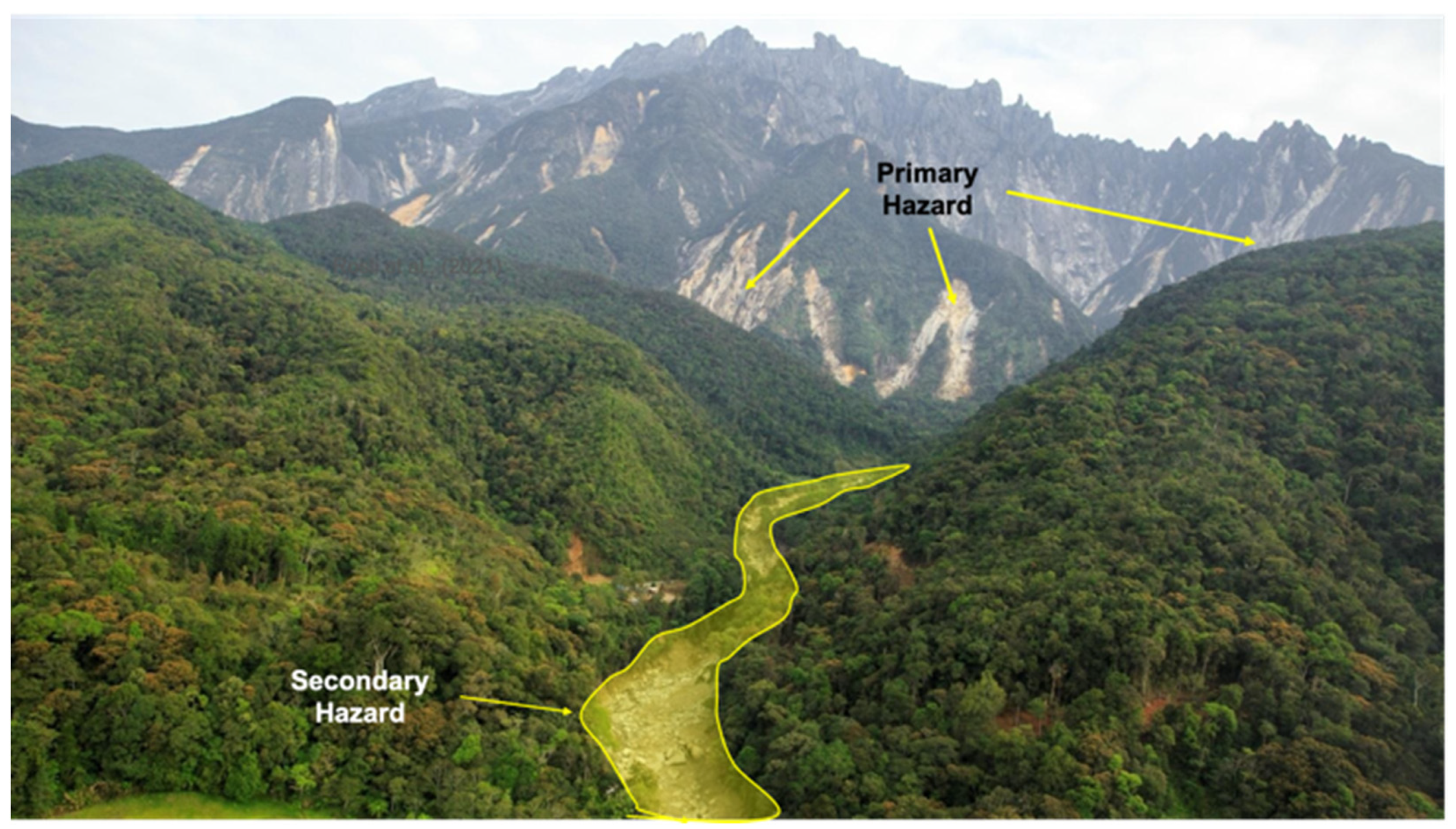
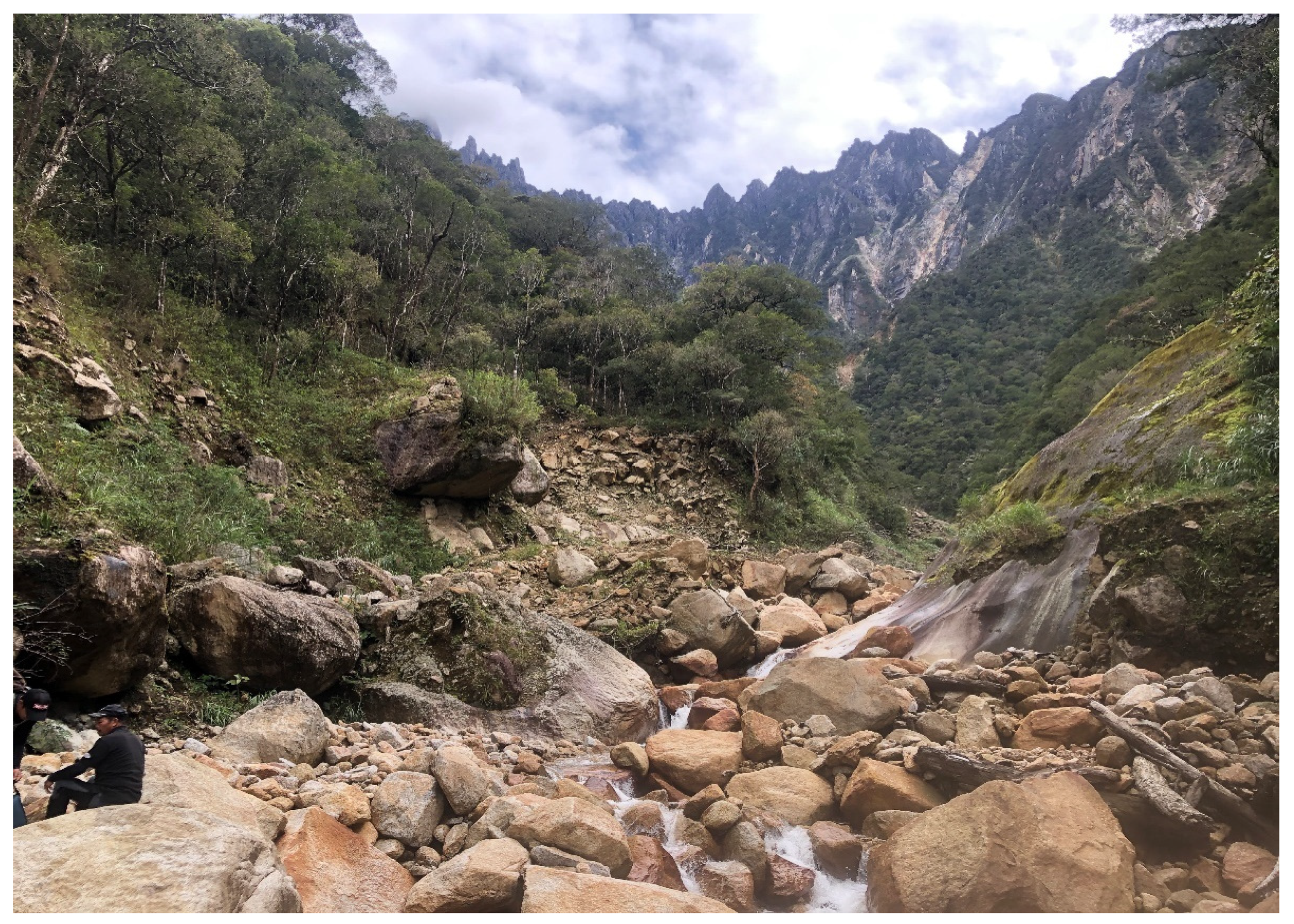
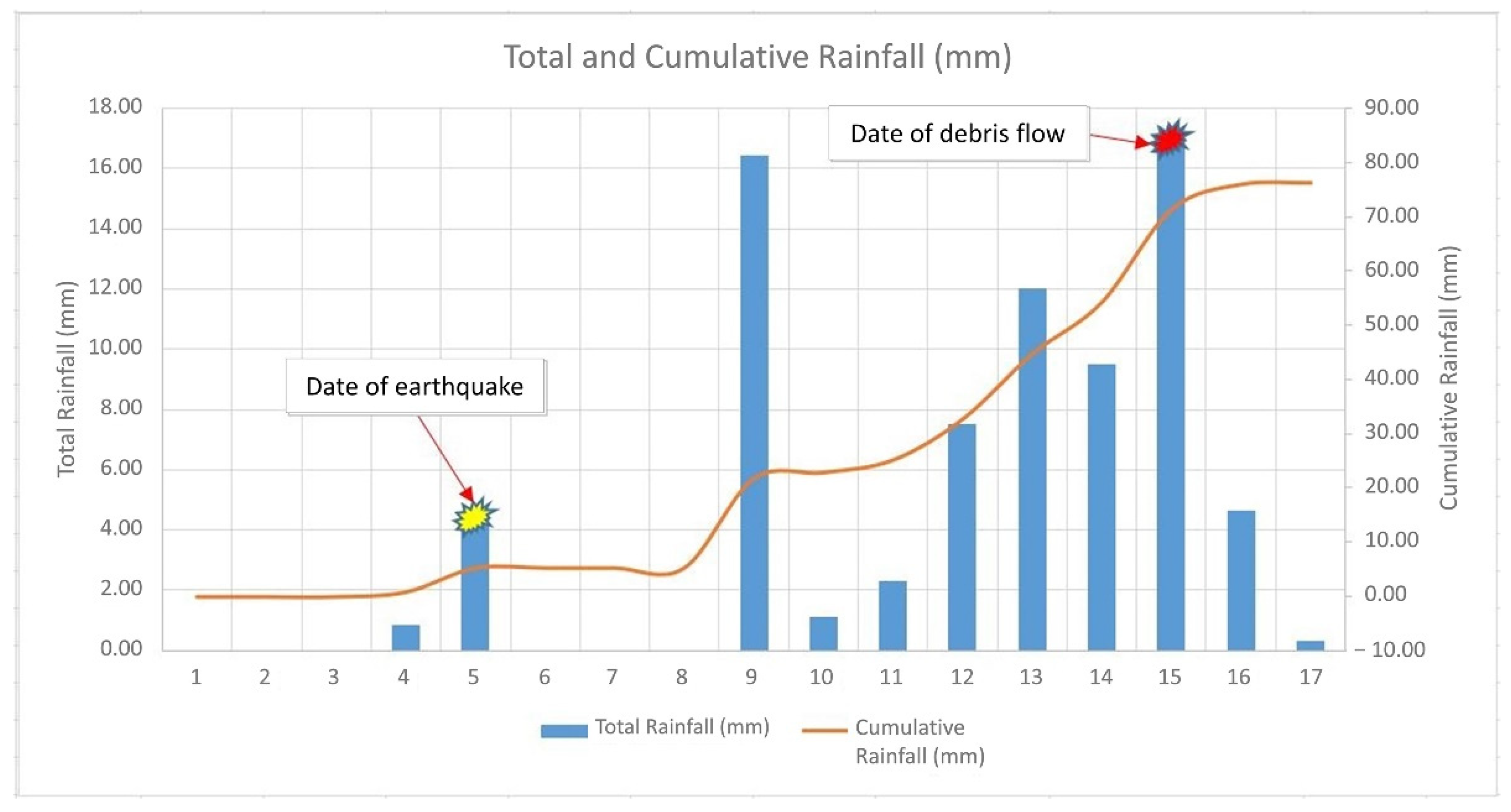
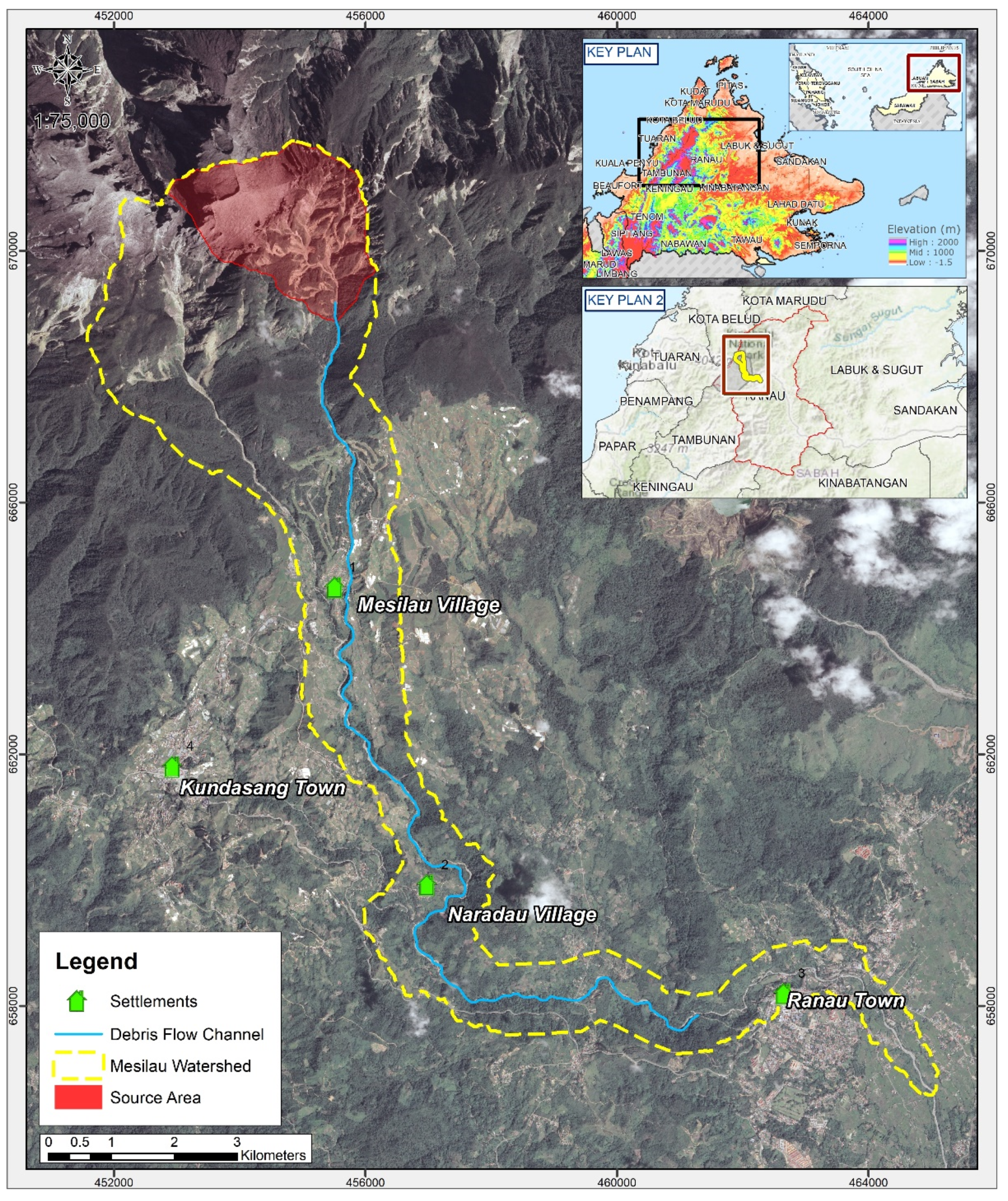
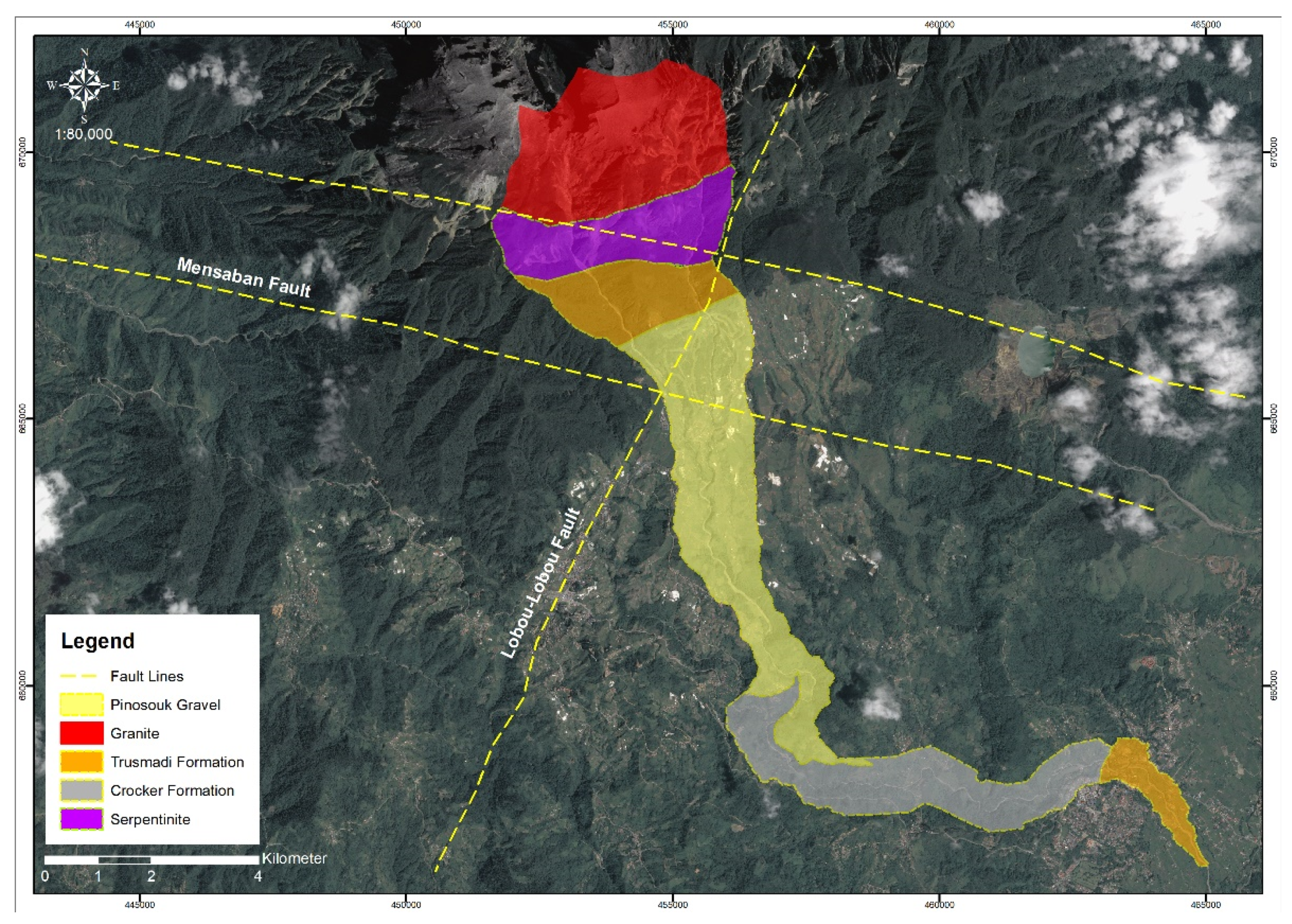
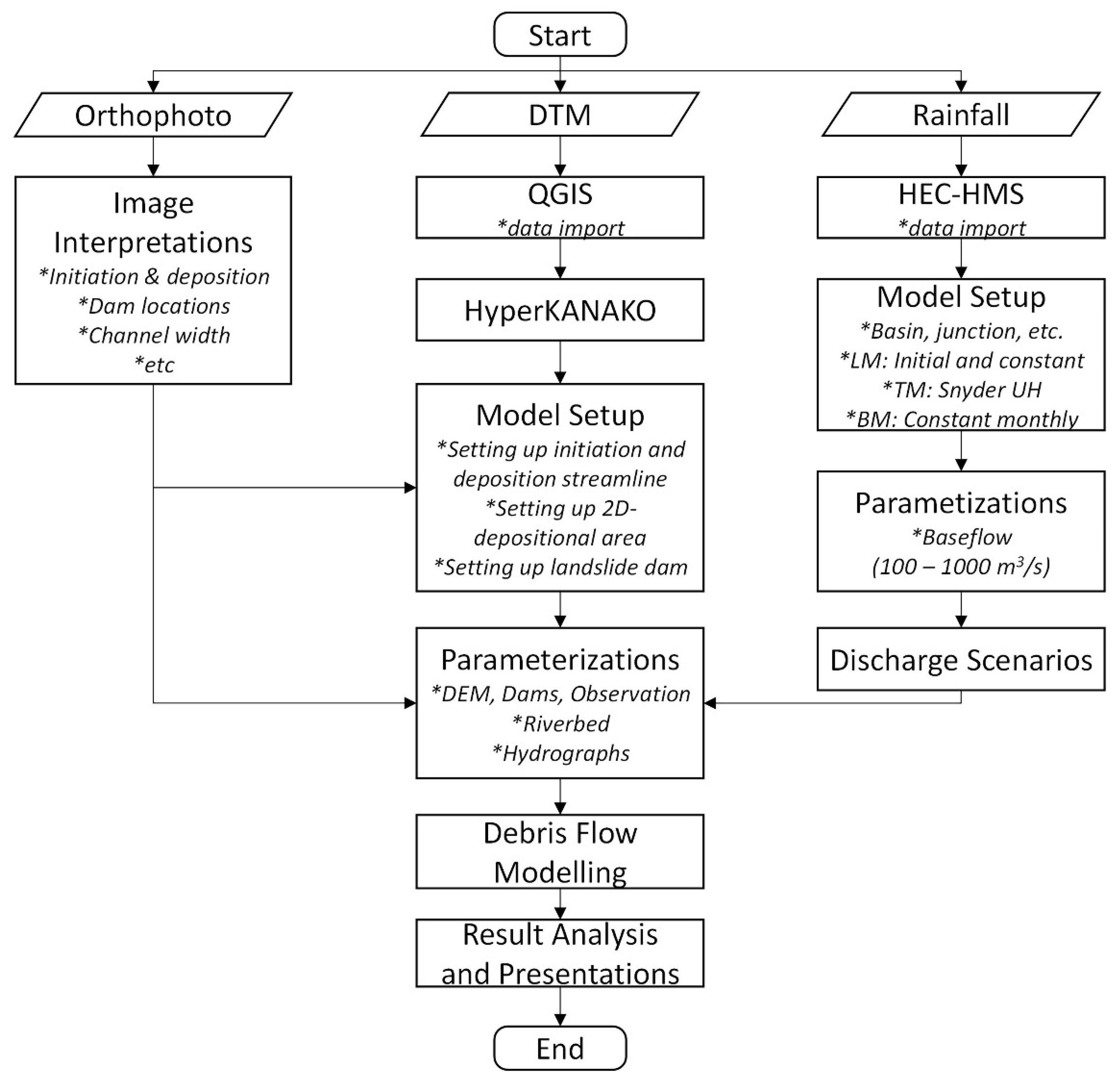
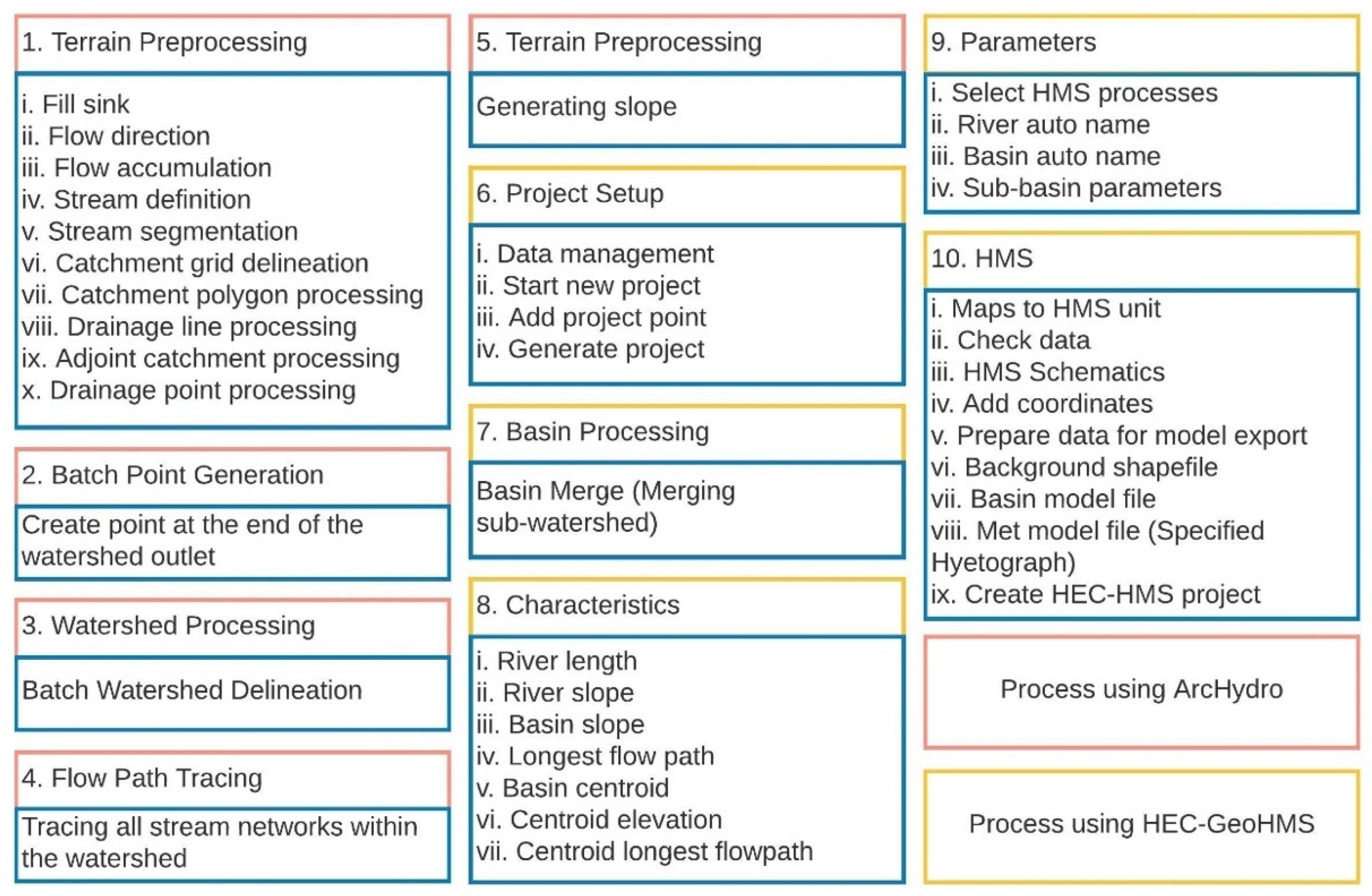

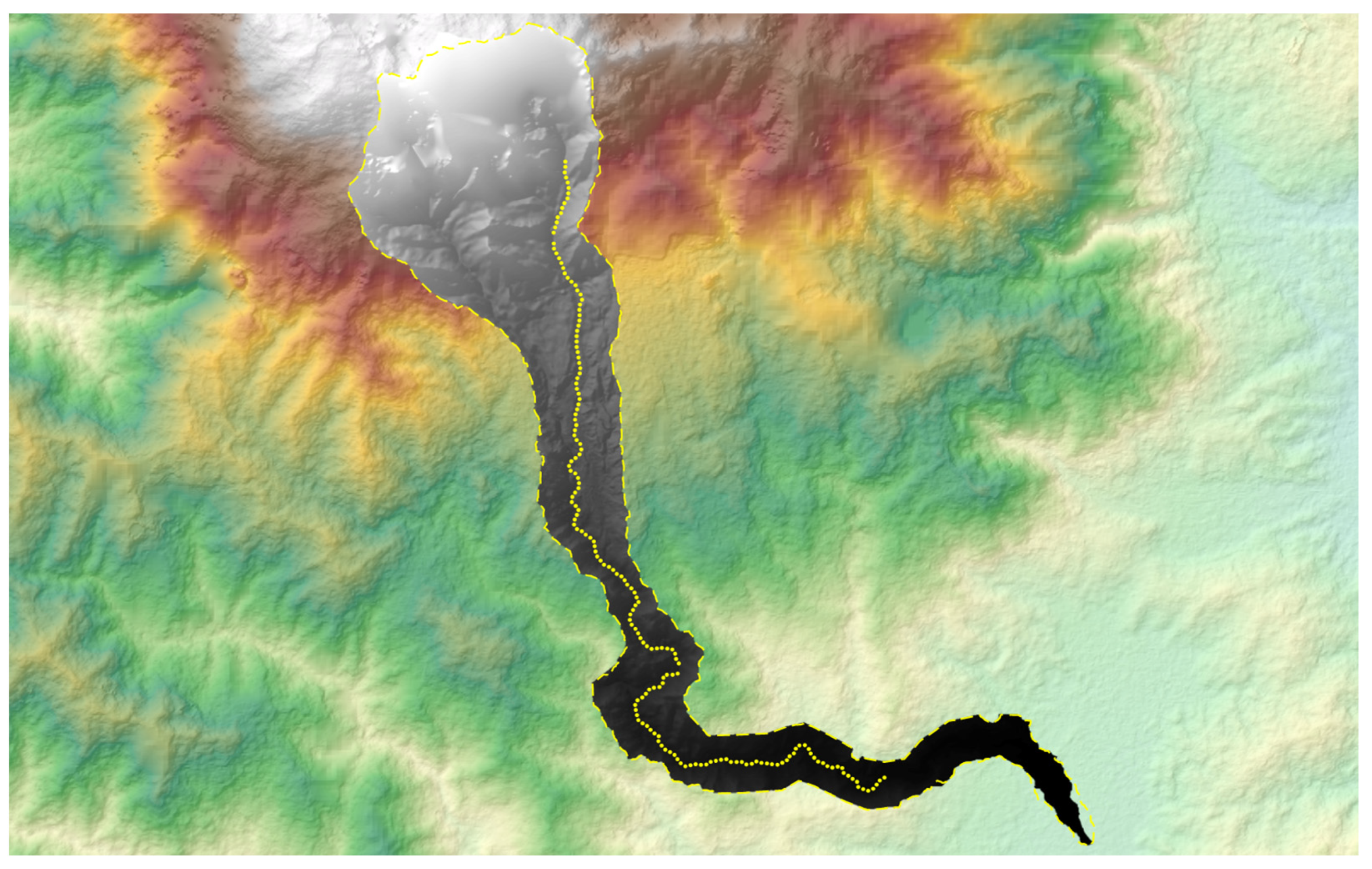
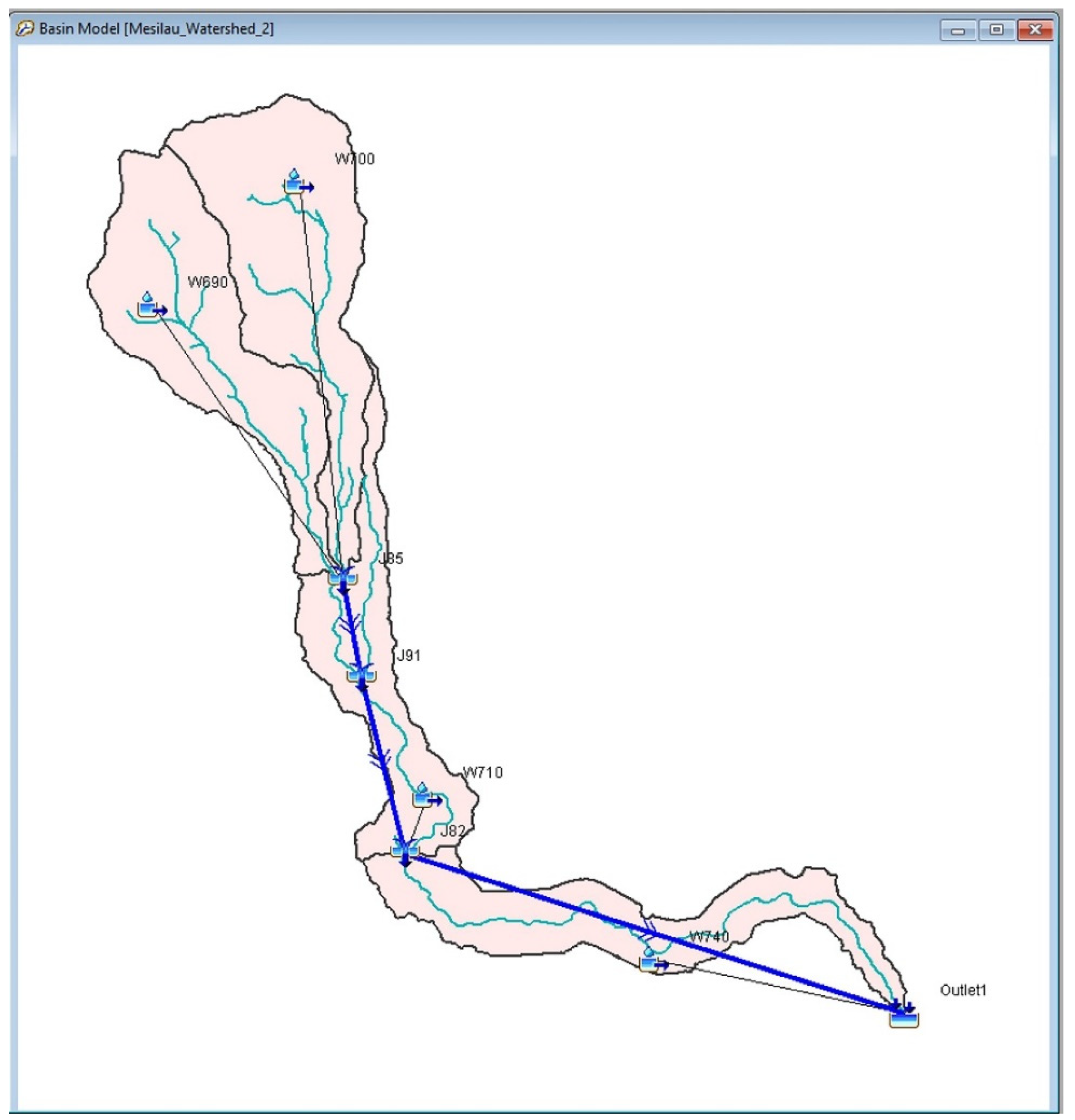
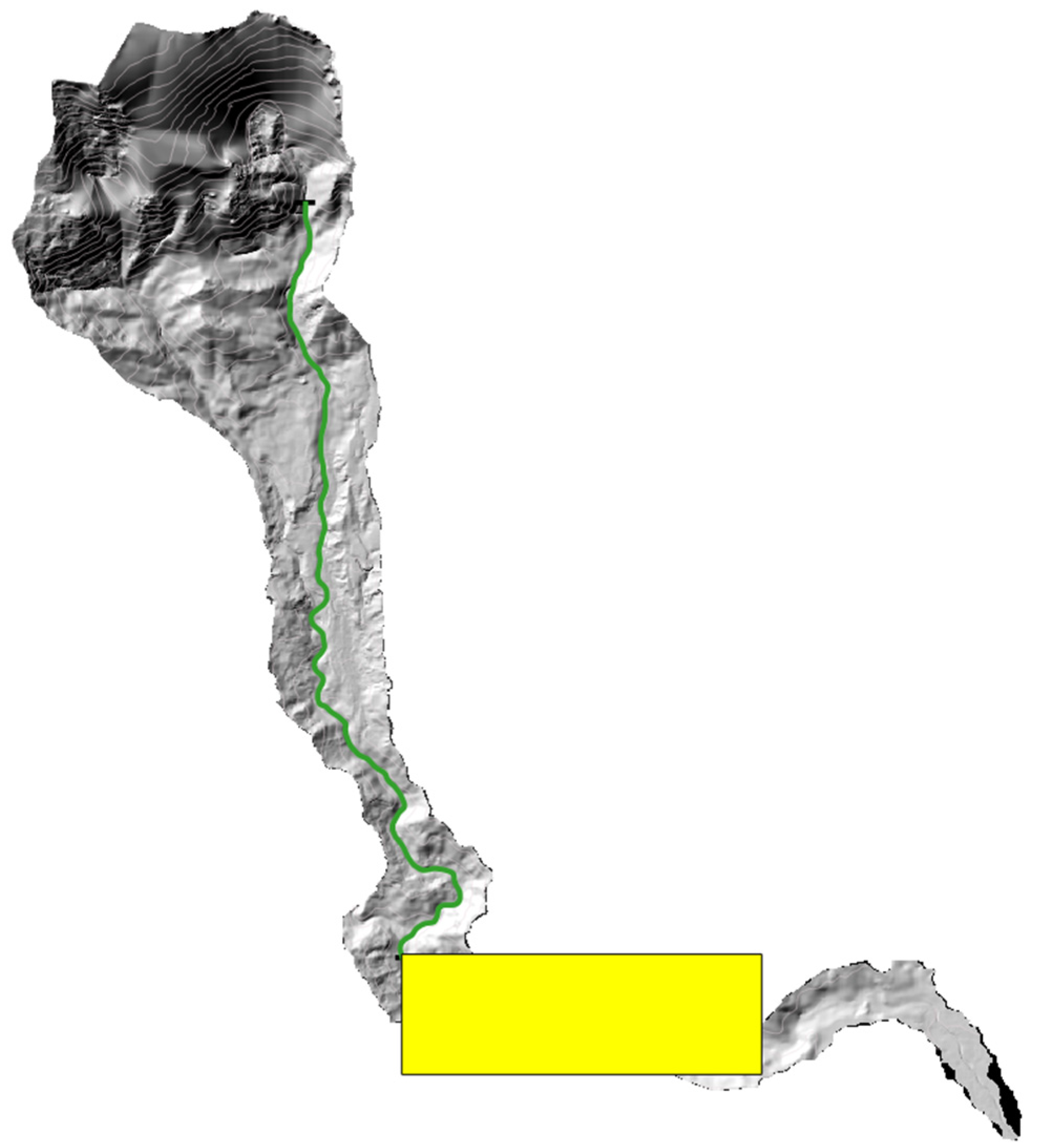

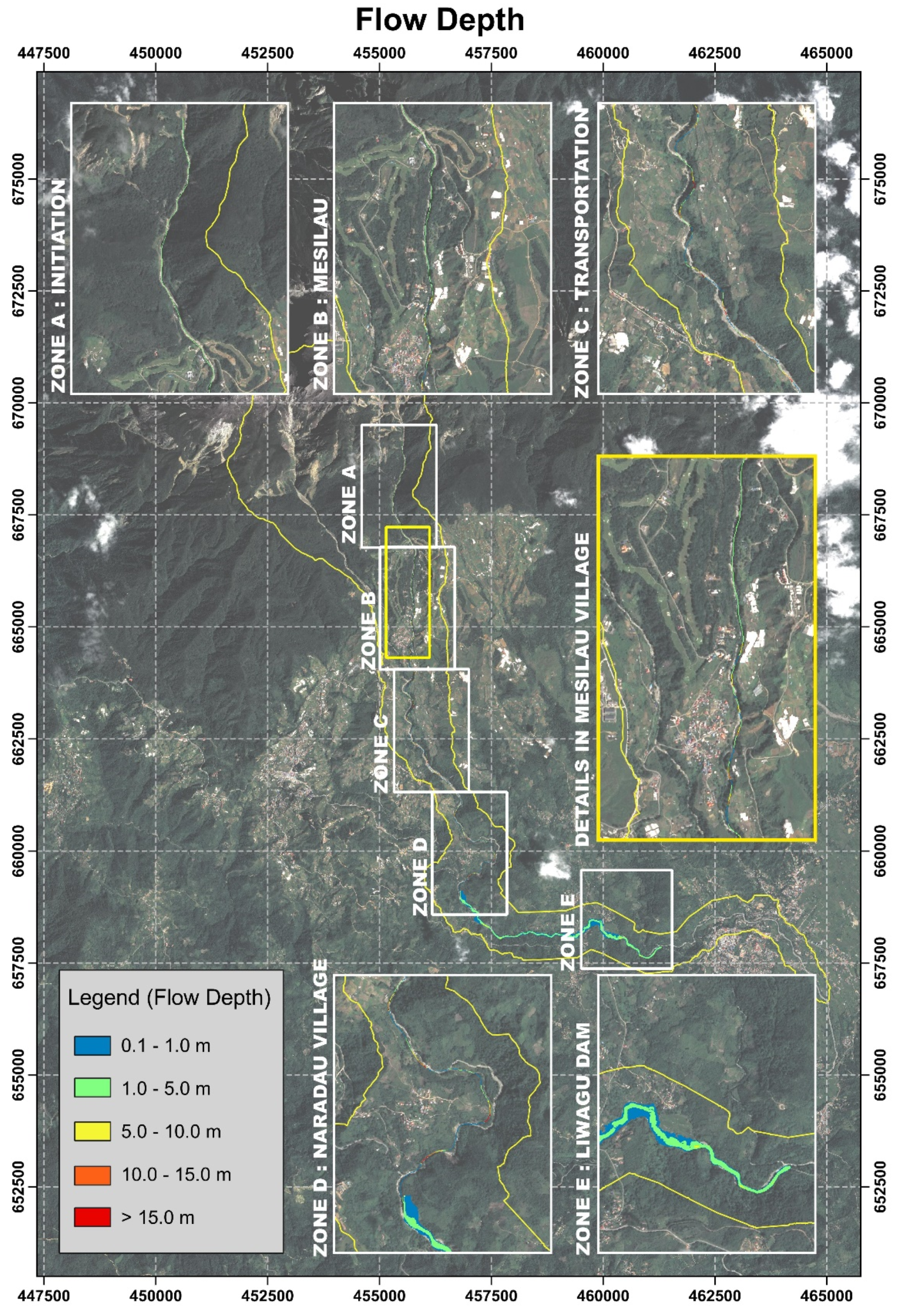
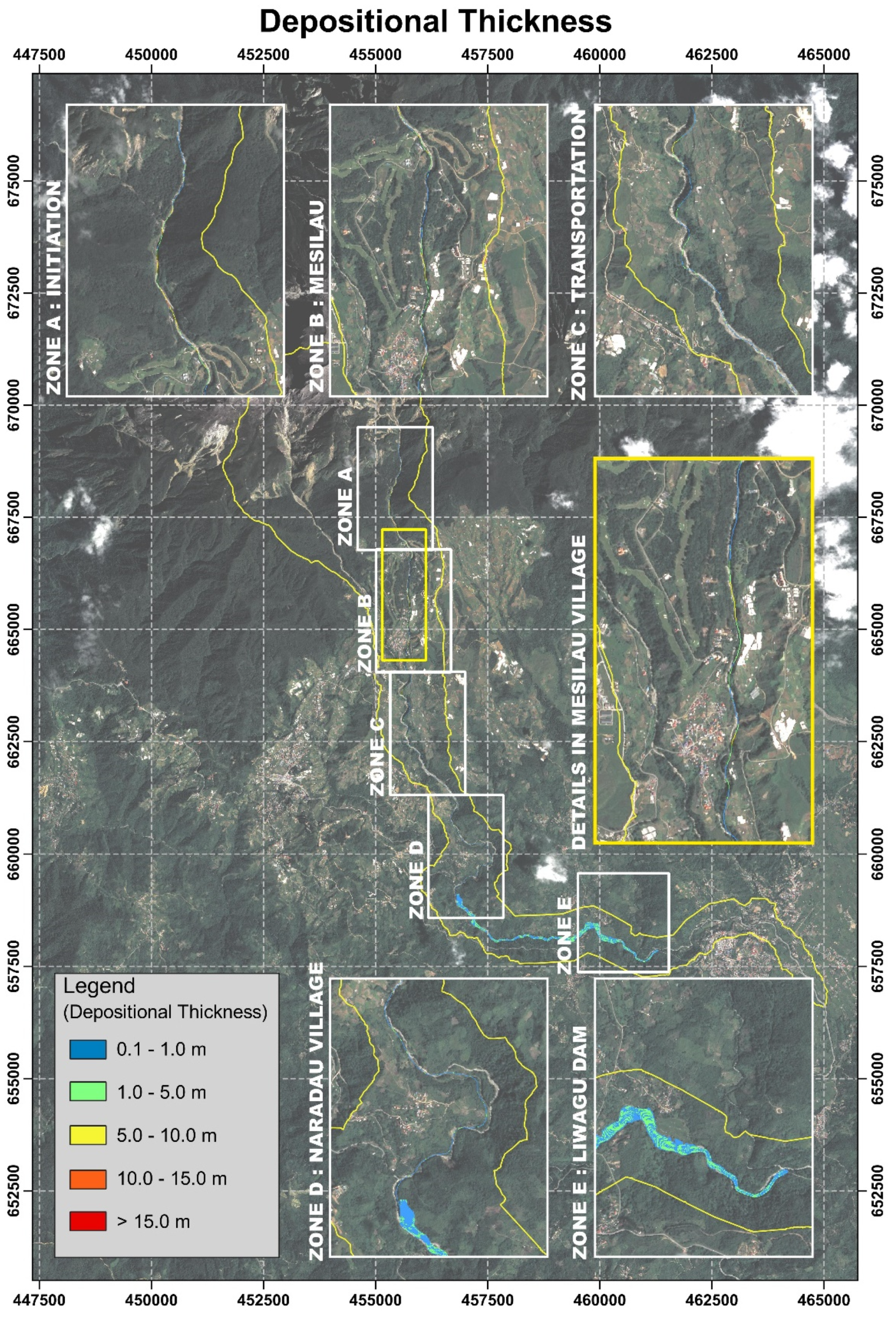
| No. | Date | Location | Triggering | Fatalities |
|---|---|---|---|---|
| 1 | 30 June 1995 | Km 38.6 Kuala Lumpur–Karak Highway, Genting Sempah, Selangor | Rainfall | 20 |
| 2 | 29 August 1996 | Kg. Orang Asli, Pos Dipang, Kampar, Perak | Rainfall | 44 |
| 3 | 26 December 1996 | Keningau, Sabah | Typhoon | 302 |
| 4 | January 2000 | Cameron Highland, Pahang | Rainfall | 6 |
| 5 | 22 September 2001 | Chinchin Village, Gombak, Selangor | Rainfall | 1 |
| 6 | 28 December 2001 | Channelized Pulai river, Gunung Pulai, Johor | Rainfall | 5 |
| 7 | 28 January 2002 | Ruan Changkul, Simunjan, Sarawak | Rainfall | 16 |
| 8 | November 2002 | Hulu Kelang, outskirt of Kuala Lumpur City | Rainfall | 8 |
| 9 | 10 November 2003 | Section 23.3 to 24.10 Kuala Kubu Baru, Selangor | Rainfall | 0 |
| 10 | 2 November 2004 | Km 52.4 Kuala Lumpur–Karak highway, Lentang | Rainfall | 0 |
| 11 | 10 November 2004 | Km 302 North South Expressway, G. Tempurung, Perak | Rainfall | 0 |
| 12 | November 2004 | Taman Harmonis, Gombak, Selangor | Rainfall | 1 |
| 13 | 12 April 2005 | Km 33 Simpang Pulai, Cameron Highland, Pahang | Rainfall | 0 |
| 14 | 15 November 2007 | Km 4 to 5 Gap, Fraser’s Hill Road, Pahang | Rainfall | 0 |
| 15 | January 2008 | Channel of Fraser Hill’s | Rainfall | 0 |
| 16 | 3 January 2009 | Section 62.4, Lojing Gua Musang Road, Kelantan | Rainfall | 0 |
| 17 | 7 August 2011 | Kampung Orang Asli Sungai Ruil, Cameron Highlands, Pahang | Rainfall | 7 |
| 18 | 23 October 2013 | Bertam valley, Cameron Highland | Rainfall | 1 |
| 19 | 5 November 2014 | Km 28, Jalan Tamparuli, Ranau, Sabah | Rainfall | 0 |
| 20 | 11 Jane 2015 | Channel of Fraser Hill’s | Rainfall | 0 |
| 21 | 18 May 2015 | Km 38.80, Jalan Penampang Tambunan Dongongan, Sabah | Rainfall | 0 |
| 22 | 15 June 2015 | Channelized Mesilau river, Kundasang, Sabah | Earthquake and rainfall | 0 |
| 23 | August 2015 | Channelized Kedamaian, and Panataran river, Kota Belud, Sabah | Earthquake and rainfall | 0 |
| Type of Dataset | Source | Resolution/Record | Date |
|---|---|---|---|
| Orthophoto | LiDAR | 0.07 m | 2016 |
| DTM (before debris flow) | IfSAR | 5.0 m | 2008 |
| DTM (after debris flow) | LiDAR | 0.25 m | 2016 |
| Rainfall | Rain-gauge | Hourly, mm | June 2015 |
| Parameters/Variables | Value | Unit |
|---|---|---|
| Simulation time | 40 | min |
| Time step | 1 | s |
| Diameter of material | 1 | m |
| Mass density of bed material | 2650 | kg/m3 |
| Mass density of fluid | 1200 | kg/m3 |
| Concentration of moveable bed | 0.2 | - |
| Internal friction angle | 35 | degree |
| Acceleration of gravity | 9.8 | m/s2 |
| Coefficient of erosion rate | 0.0007 | - |
| Coefficient of deposition rate | 0.05 | - |
| Manning’s roughness coefficient | 0.03 | s/m1/3 |
| Number of calculation points | 250 | - |
| Interval of 1D calculation points | 5 | m |
| Number of 2D calculation points | 480 × 160 | - |
| Interval of 2D calculation points | 5 × 5 | m × m |
| Scenario | Baseflow (m3/s) | Hydrograph (m3/s) | Simulation Runout Distance |
|---|---|---|---|
| Scenario 1 | 100 | 113.8 | Short |
| Scenario 2 | 200 | 213.8 | Short |
| Scenario 3 | 300 | 313.8 | Short |
| Scenario 4 | 400 | 413.8 | Short |
| Scenario 5 | 500 | 513.8 | Almost reach |
| * Scenario BF | 550 | 563.8 | Best-fit |
| Scenario 6 | 600 | 613.8 | Over-estimate |
| Scenario 7 | 700 | 713.8 | Over-estimate |
| Scenario 8 | 800 | 813.8 | Over-estimate |
| Scenario 9 | 900 | 913.8 | Over-estimate |
| Scenario 10 | 1000 | 1013.8 | Over-estimate |
| Zones | Colour Range | Flow Depth (m) |
|---|---|---|
| Zone A (Initiation area) | green to orange | 1.0–15.0 |
| Zone B (Mesilau village) | green to yellow | 1.0–10.0 |
| Zone C (Transportation area) | blue to yellow | 0.1–10.0 |
| Zone D (Naradau village) | blue to green | 0.1–5.0 |
| Zone E (Liwagu Dam) | blue to green | 0.1–5.0 |
| Zones | Colour Range | Depositional Thickness (m) |
|---|---|---|
| Zone A (Initiation area) | green to orange | 1.0–15.0 |
| Zone B (Mesilau village) | blue to yellow | 0.1–10.0 |
| Zone C (Transportation area) | blue to green | 0.1–5.0 |
| Zone D (Naradau village) | blue to green | 0.1–5.0 |
| Zone E (Liwagu dam) | blue to green | 0.1–5.0 |
Publisher’s Note: MDPI stays neutral with regard to jurisdictional claims in published maps and institutional affiliations. |
© 2021 by the authors. Licensee MDPI, Basel, Switzerland. This article is an open access article distributed under the terms and conditions of the Creative Commons Attribution (CC BY) license (https://creativecommons.org/licenses/by/4.0/).
Share and Cite
Rosli, M.I.; Che Ros, F.; Razak, K.A.; Ambran, S.; Kamaruddin, S.A.; Nor Anuar, A.; Marto, A.; Tobita, T.; Ono, Y. Modelling Debris Flow Runout: A Case Study on the Mesilau Watershed, Kundasang, Sabah. Water 2021, 13, 2667. https://doi.org/10.3390/w13192667
Rosli MI, Che Ros F, Razak KA, Ambran S, Kamaruddin SA, Nor Anuar A, Marto A, Tobita T, Ono Y. Modelling Debris Flow Runout: A Case Study on the Mesilau Watershed, Kundasang, Sabah. Water. 2021; 13(19):2667. https://doi.org/10.3390/w13192667
Chicago/Turabian StyleRosli, Muhammad Iylia, Faizah Che Ros, Khamarrul Azahari Razak, Sumiaty Ambran, Samira Albati Kamaruddin, Aznah Nor Anuar, Aminaton Marto, Tetsuo Tobita, and Yusuke Ono. 2021. "Modelling Debris Flow Runout: A Case Study on the Mesilau Watershed, Kundasang, Sabah" Water 13, no. 19: 2667. https://doi.org/10.3390/w13192667
APA StyleRosli, M. I., Che Ros, F., Razak, K. A., Ambran, S., Kamaruddin, S. A., Nor Anuar, A., Marto, A., Tobita, T., & Ono, Y. (2021). Modelling Debris Flow Runout: A Case Study on the Mesilau Watershed, Kundasang, Sabah. Water, 13(19), 2667. https://doi.org/10.3390/w13192667






